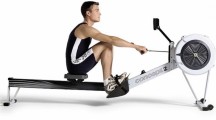Abstract
During the rowing stroke, the respiratory muscles are responsible for postural control, trunk stabilisation, generation/transmission of propulsive forces and ventilation (Bierstacker et al. in Int J Sports Med 7:73–79, 1986; Mahler et al. in Med Sci Sports Exerc 23:186–193, 1991). The challenge of these potentially competing requirements is exacerbated in certain parts of the rowing stroke due to flexed (stroke ‘catch’) and extended postures (stroke ‘finish’). The purpose of this study was to assess the influence of the postural role of the trunk muscles upon pressure and flow generating capacity, by measuring maximal respiratory pressures, flows, and volumes in various seated postures relevant to rowing. Eleven male and five female participants took part in the study. Participants performed two separate testing sessions using two different testing protocols. Participants performed either maximal inspiratory or expiratory mouth pressure manoeuvres (Protocol 1), or maximal flow volume loops (MFVLs) (Protocol 2), whilst maintaining a variety of specified supported or unsupported static rowing-related postures. Starting lung volume was controlled by initiating the test breath in the upright position. Respiratory mouth pressures tended to be lower with recumbency, with a significant decrease in P Emax in unsupported recumbent postures (3–9 % compared to upright seated; P = 0.036). There was a significant decrease in function during dynamic manoeuvres, including PIF (5–9 %), FVC (4–7 %) and FEV1 (4–6 %), in unsupported recumbent postures (p < 0.0125; Bonferroni corrected). Thus, respiratory pressure and flow generating capacity tended to decrease with recumbency; since lung volumes were standardised, this may have been, at least in part, influenced by the postural co-contraction of the trunk muscles.

Similar content being viewed by others
References
American Thoracic Society/European Respiratory Society (ATS/ERS) (2005) Standardization on lung function testing: standardization of spirometry. Eur Resp J 26:319–338
Badr C, Elkins MR, Ellis ER (2002) The effect of body position on maximal expiratory pressure and flow. Aust J Physiother 48:95–102
Bierstacker M, Bierstacker WA, Schreurs A (1986) Reduction of lung elasticity due to training and expiratory flow limitation during exercise in competitive female rowers. Int J Sports Med 7:73–79
Bland JM, Altman DG (1986) Statistical methods for assessing agreement between two methods of clinical measurement. Lancet 8:307–310
Castile R, Mead J, Jackson A, Wohl ME, Stokes D (1982) Effects of posture on flow-volume curve configuration in normal humans. J Appl Physiol Respir Environ Exerc Physiol 53:1175–1183
D’Angelo E, Agostini A (1995) Statics of the chest wall. In: Roussos C (ed) The thorax, 2nd edn., part A. Dekker, New York, pp 457–494
Hodges PW, Gandevia SC (2000) Changes in intra-abdominal pressure during postural and respiratory activation of the human diaphragm. J Appl Physiol 89:967–976
Kera T, Maruyama H (2005) The effect of posture on respiratory activity of the abdominal muscles. J Physiol Anthropol Appl Hum Sci 24:259–265
Lomax ME, McConnell AK (2009) Influence of prior activity (warm-up) and inspiratory muscle training upon between- and within-day reliability of maximal inspiratory pressure measurement. Respiration 78:197–202
Mahler DA, Nelson WN, Hagerman FC (1984) Mechanical and physiological evaluation of exercise performance in elite national rowers. J Am Med Assoc 252:496–499
Mahler DA, Shuhart CR, Brew E, Stukel TA (1991) Ventilatory responses and entrainment of breathing during rowing. Med Sci Sports Exerc 23:186–193
McCool D (2006) Global physiology and pathophysiology of cough: ACCP evidence-based clinical practice guidelines. Chest 129:48S–53S
Meysman M, Vincken W (1998) Effect of body posture on spirometric values and upper airway obstruction indices derived from the flow-volume loop in young non-obese subjects. Chest 114:1042–1047
Ogiwara S, Miyachi T (2002) Effect of posture on ventilatory muscle strength. J Phys Therapy Sci 14:1–5
Romer L, Polkey MI (2008) Exercise-induced respiratory muscle fatigue: implications for performance. J Appl Physiol 104:879–888
Siegmund GP, Edwards MR, Moore KS, Tiessen DA, Sanderson DJ, McKenzie DC (1999) Ventilation and locomotion coupling in varsity male rowers. J Appl Physiol 87:233–242
Talwar A, Sood S, Sethi J (2002) Effect of body posture on dynamic lung function in young non-obese Indian subjects. Indian J Med Sci 56:607–612
Tsubaki A, Deguchi S, Yoneda Y (2009) Influence of posture on respiratory function and respiratory muscle strength in normal healthy subjects. J Phys Ther Sci 21:71–74
Vilke GM, Chan TC, Neuman T, Clausen JL (2000) Spirometry in normal subjects in sitting, prone and supine positions. Respir Care 45:407–410
Volianitis S, McConnell AK, Jones DA (2001) Assessment of maximum inspiratory pressure: prior submaximal respiratory muscle activity (‘warm-up’) enhances maximum inspiratory activity and attenuates the learning effect of repeated measurement. Respiration 68:22–27
Zar JH (1998) Biostatistical analysis. Prentice Hall, London
Conflict of interest
AKM declares a beneficial interest in the POWERbreathe® inspiratory muscle trainer in the form of a share of license income to the University of Birmingham, as well as acting as a consultant to HaB International Ltd. LAG has no potential conflicts of interest.
Author information
Authors and Affiliations
Corresponding author
Additional information
Communicated by Susan A. Ward.
Rights and permissions
About this article
Cite this article
Griffiths, L.A., McConnell, A.K. The influence of rowing-related postures upon respiratory muscle pressure and flow generating capacity. Eur J Appl Physiol 112, 4143–4150 (2012). https://doi.org/10.1007/s00421-012-2399-4
Received:
Accepted:
Published:
Issue Date:
DOI: https://doi.org/10.1007/s00421-012-2399-4




